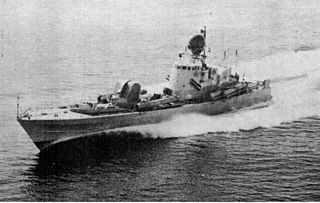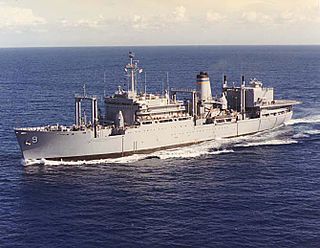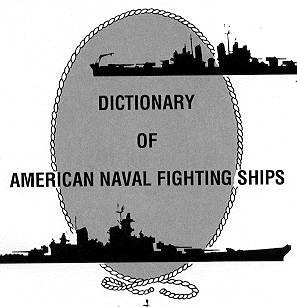
The fast combat support ship is the United States Navy's largest combat logistics ship, designed as an oiler, ammunition and supply ship. All fast combat support ships currently in service are operated by Military Sealift Command. The AOE has the speed to keep up with carrier battle groups and the capacity to fully support their needs. It receives petroleum products, ammunition and stores from various shuttle ships and redistributes these items when needed to ships in the carrier battle group. This greatly reduces the number of service ships needed to travel with carrier battle groups.

The Oliver Hazard Perry class is a class of guided missile frigates named after the U.S. Commodore Oliver Hazard Perry, the hero of the naval Battle of Lake Erie. Also known as the Perry or FFG-7 class, the warships were designed in the United States in the mid-1970s as general-purpose escort vessels inexpensive enough to be bought in large quantities to replace World War II-era destroyers and complement 1960s-era Knox-class frigates. In Admiral Elmo Zumwalt's "high low fleet plan", the FFG-7s were the low capability ships with the Spruance-class destroyers serving as the high capability ships. Intended to protect amphibious landing forces, supply and replenishment groups, and merchant convoys from aircraft and submarines, they were also later part of battleship-centred surface action groups and aircraft carrier battle groups/strike groups. Fifty-five ships were built in the United States: 51 for the United States Navy and four for the Royal Australian Navy (RAN). In addition, eight were built in Taiwan, six in Spain, and two in Australia for their navies. Former U.S. Navy warships of this class have been sold or donated to the navies of Bahrain, Egypt, Poland, Pakistan, Taiwan and Turkey.

The Arleigh Burke class of guided missile destroyers (DDGs) is the United States Navy's first class of destroyer built around the Aegis Combat System and the SPY-1D multifunction passive electronically scanned array radar. The class is named for Admiral Arleigh Burke, an American destroyer officer in World War II, and later Chief of Naval Operations. The class leader, USS Arleigh Burke, was commissioned during Admiral Burke's lifetime.

The Boston Navy Yard, originally called the Charlestown Navy Yard and later Boston Naval Shipyard, was one of the oldest shipbuilding facilities in the United States Navy. It was established in 1801 as part of the recent establishment of the new U.S. Department of the Navy in 1798. After 175 years of military service, it was decommissioned as a naval installation on 1 July 1974.

Destroyer escort (DE) was the United States Navy mid-20th-century classification for a 20-knot (23 mph) warship designed with endurance to escort mid-ocean convoys of merchant marine ships. Kaibōkan were designed for a similar role in the Imperial Japanese Navy. The Royal Navy and Commonwealth forces identified such warships as frigates, and that classification was widely accepted when the United States redesignated destroyer escorts as frigates (FF) in 1975. Destroyer escorts, frigates, and kaibōkan were mass-produced for World War II as a less expensive antisubmarine warfare alternative to fleet destroyers. Other similar warships include the 10 Kriegsmarine escort ships of the F-class and the two Amiral Murgescu-class vessels of the Romanian Navy.

The Tacoma class of patrol frigates served in the United States Navy during World War II and the Korean War. Originally classified as a gunboat (PG), they were reclassified as a patrol frigate (PF) on 15 April 1943. The class is named for its lead ship, Tacoma, a Maritime Commission (MARCOM) S2-S2-AQ1 design, which in turn was named for the city of Tacoma, Washington. Twenty-one ships were transferred to the British Royal Navy, in which they were known as Colony-class frigates, and twenty-eight ships were transferred under Lend-Lease to the Soviet Navy, where they were designated as a storozhevoi korabl, during World War II. All Tacoma-class ships in US service during World War II were manned by United States Coast Guard crews. Tacoma-class ships were transferred to the United States Coast Guard and various navies post-World War II.

Combat stores ships, or Storeships were originally a designation given to ships in the Age of Sail and immediately afterward that navies used to stow supplies and other goods for naval purposes. Today, the United States Navy and the Royal Navy operate modern combat store ships. The Sirius and Mars classes and the Fort Rosalie and Fort Victoria classes provide supplies, including frozen, chilled and dry provisions, and propulsion and aviation fuel to combatant ships that are at sea for extended periods of time. Storeships should not be confused with fast combat support ships or tenders.
134 is the natural number following 133 and preceding 135.

The Evarts-class destroyer escorts were destroyer escorts launched in the United States in 1942–44. They served in World War II as convoy escorts and anti-submarine warfare ships. They were also known as the GMT or "short hull" DE class, with GMT standing for General Motors Tandem Diesel drive.

The Buckley-class destroyer escorts were 102 destroyer escorts launched in the United States in 1943–44. They served in World War II as convoy escorts and anti-submarine warfare ships. The lead ship was USS Buckley which was launched on 9 January 1943. The ships had General Electric steam turbo-electric transmission. The ships were prefabricated at various factories in the United States, and the units brought together in the shipyards, where they were welded together on the slipways.
Spica is the brightest star in the constellation Virgo.

The Cannon class was a class of destroyer escorts built by the United States primarily for ocean antisubmarine warfare escort service during World War II. The lead ship, USS Cannon, was commissioned on 26 September 1943 at Wilmington, Delaware. Of the 116 ships ordered, 44 were cancelled and six were commissioned directly into the Free French Forces. Destroyer escorts were regular companions escorting the vulnerable cargo ships.

HSwMS Spica (T121) is a former Swedish Navy Spica-class, torpedo-armed, fast attack craft (FAC), now a museum ship at the Vasa Museum in Stockholm, Sweden.
Rescue and salvage ships are a type of military salvage tug. They are tasked with coming to the aid of stricken vessels. Their general mission capabilities include combat salvage, lifting, towing, retraction of grounded vessels, off-ship firefighting, and manned diving operations. They were common during World War II.

USNS Spica (T-AFS-9), was a combat stores ship acquired by the U.S. Navy from the United Kingdom in 1981. She served as part of the Military Sealift Command until she was deactivated in 2008.















